Cool and hot science for a bright future Understand article
Science in School is published by EIROforum, a collaboration between eight of Europe’s largest inter-governmental scientific research organisations. This article reviews some of the latest news from the EIROforum members (EIROs).

EIROforum
EIROforum combines the resources, facilities and expertise of its member organisations to support European science in reaching its full potential.
CERN: proudly presenting the new (Higgs?) boson
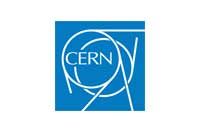
On 4 July 2012, the ATLAS and CMS experiments at CERN’s Large Hadron Collider (LHC) announced the discovery of a new particle with a mass of about 126 GeV and characteristics similar to those expected for the long-sought Higgs boson. This discovery is a major step forward in our understanding of the origin of mass, and of the fundamental properties of matter, space and time.
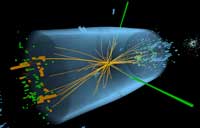
collisions at a centre of
mass energy of 8 TeV,
recorded with the CMS
detector, which contributed
to the discovery of the new
particle.
Image courtesy of CERN
The preliminary results come from data taken in 2011 and 2012, corresponding to about 1015 proton-proton collisions at 7 and 8 TeV energy. More data will be needed to study the different decay modes of the new particle, to find out if the theoretical predictions are correct, or if there are any – even tiny – differences between the predictions of the Higgs model and the observations.
- Find out more about the search for the Higgs in this issue’s feature article:
Hayes E (2012) Accelerating the pace of science: interview with CERN’s Rolf Heuer. Science in School 25: 6-12. - To learn more about how the LHC works and the search for the Higgs boson, see:
Landua R, Rau M (2008) The LHC: a step closer to the Big Bang. Science in School 10: 26-33.
Landua R (2008) The LHC: a look inside. Science in School 10: 34-45. - Based in Geneva, Switzerland, CERN is the world’s largest particle physics laboratory.
EFDA-JET: paving the tungsten-tile road to ITER
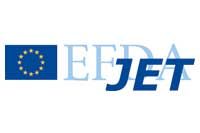
ITER, the world’s biggest fusion experiment, is under construction in the south of France. During its construction, the Joint European Torus (JET) – currently Europe’s largest fusion experiment – is a vital test bed for ITER design and operation.

is mounted on a 6 m
articulated boom, which
allows maintenance without
humans entering the JET
vessel. An operator in a
remote control room
controls the mascot’s two
gripper arms, which can
operate around 1500
bespoke tools.
Image courtesy of EFDA-JET
In this capacity, JET has successfully completed its 2011-2012 experimental campaign by running 151 identical high-powered plasma pulses, totalling 900 seconds of stable operating time.
This emulates a single pulse of ITER – by virtue of its superconducting magnets, ITER will be able to maintain a stable pulse 20 times longer than JET. On the basis of the recent experiments, scientists are confident that they will be able to maintain stable fusion conditions for the length of these longer pulses. The experiment also tested the long-term behaviour of the wall materials – a range of JET’s wall tiles will now be extracted by the remote-handling system (pictured) for analysis.
The ITER design team are very interested in the results, and have already requested an even more severe test for the materials when experiments recommence next year: deliberate melting of some tungsten wall tiles.
- Situated in Culham, UK, JET is Europe’s fusion device. Scientific exploitation of JET is undertaken through the European Fusion Development Agreement (EFDA).
EMBL: ENCODEing the switchboard of the human genome

For the past five years, hundreds of scientists in the ‘Encyclopaedia of DNA elements’ (ENCODE) project have been systematically exploring what the human genome does, to identify all its functional elements. Their findings show that much of what has been called ‘junk DNA’ is actually a massive, 3D switchboard turning genes on and off.
Together with colleagues from around the globe, scientists at EMBL’s European Bioinformatics Institute have found that while only 2% of our DNA is genes, a much bigger part of the genome – at least 20% – is involved in controlling when and where those genes are active, and as much as 80% of the genome has a distinct biochemical activity. This opens up new avenues of biomedical research.
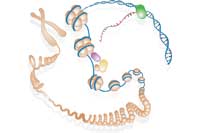
that most of our DNA has a
function: controlling when
and where genes are turned
on and off.
Image courtesy of EMBL-EBI
To give some sense of the scale of the project, ENCODE used around 300 years’ worth of computer time studying 147 tissue types to determine what turns specific genes on and off, and how that ‘switch’ differs between cell types. All of the data is now publicly available and the findings are published in 30 connected, open-access papers in three science journals: Nature, Genome Biology and Genome Research.
- For more details including the full publication list, see the press release on the EMBL website.
- What is the ENCODE project all about? Watch a video interview with leading scientists Ewan Birney, Tim Hubbard and Roderic Guigo.
- Learn how the insights from the ENCODE project were represented in the ‘Dance of the DNA’ at the Science Museum, London, UK.
- EMBL is Europe’s leading laboratory for basic research in molecular biology, with its headquarters in Heidelberg, Germany. The European Bioinformatics Institute is part of EMBL and is based in Cambridge, UK.
ESA: The Arctic ice cap is thinning

The year 2012 saw the surface area of Arctic sea ice hit a record low since satellite measurements began in the 1970s. The consequence of losing part of the Arctic’s ice coverage could be profound: the ice cap reflects sunlight back into space; sunlight that, unless reflected, would contribute to global warming.
The European Space Agency (ESA)’s satellites SMOS and CryoSat have found that not only is the area of sea-ice getting smaller but the ice is also getting thinner: 900 km3 of summer sea ice have disappeared from the Arctic ocean over the past year, a rate of loss that is 50% higher than most scenarios outlined by polar scientists.

mission is dedicated to
precisely monitoring
changes in the thickness of
marine ice floating on the
polar oceans, and variations
in the thickness of the vast
ice sheets that blanket
Greenland and Antarctica.
Image courtesy of ESA / AOES
Medialab
In addition to the total ice volume, it is important to evaluate the thickness of the young ice that forms in winter.
Only those areas thick enough to survive the next summer’s melting period can become the basis of the following winter’s thick ice. It is this thick, multi-year ice that ultimately indicates how healthy the Arctic is.
ESA’s measurements show that this newly formed ice is becoming significantly thinner each year, so that less and less of it survives the summer. In particular, SMOS detected extensive areas less than half a metre thick. Scientists therefore predict that of the total Arctic sea-ice cover for Winter 2012-13, a larger fraction than ever before (about 12 million km2) will consist of thin ice. This suggests that less Arctic sea-ice than ever before will survive the melting phase in Summer 2013.
- To model the effect of the changing ice cover with your students in class, see:
Shallcross D, Harrison T (2008) Climate change modelling in the classroom. Science in School 9: 28-33. - ESA is Europe’s gateway to space, with its headquarters in Paris, France.
ESO: Sweet discovery in space
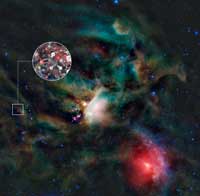
region seen in infrared light.
IRAS 16293-2422 is the red
object in the centre of the small
square. Inset: an artist’s
impression of glycolaldehyde
molecules, the form of sugar
that has been found around
IRAS 16293-2422.
Image courtesy of ALMA (ESO /
NAOJ / NRAO) / L Calçada (ESO)
& NASA / JPL-Caltech / WISE Team

Astronomers using ALMA, one of the world’s largest ground-based astronomy projects, have spotted molecules of glycolaldehyde – a simple form of sugar – around a young binary star with similar mass to the Sun, called IRAS 16923-2422. Glycolaldehyde (C2H4O2) has been seen in interstellar space before, but this is the first time it has been found so near to a Sun-like star.
The molecule is one of the ingredients in the formation of RNA, which – like DNA, to which it is similar – is one of the building blocks of life. The discovery shows that these building blocks are in the right place, at the right time, to be included in planets forming around the star.
- For more information, see the press release.
- To learn more about ALMA, see:
Mignone C, Pierce-Price D (2010) The ALMA observatory: the sky is only one step away. Science in School 15: 44-49. - The European Southern Observatory (ESO) is by far the world’s most productive ground-based astronomical observatory, with its headquarters in Garching near Munich, Germany, and its telescopes in Chile. ESO is the European partner in the ALMA project, which is a collaboration between Europe, North America and East Asia, in co-operation with the Republic of Chile.
ESRF: Hot ice in Neptune

The main constituents of the planets Neptune and Uranus are water, ammonia and methane in solid phases called ‘ices’. They are very different from ice on Earth, though: up to 5000 K hot and under extreme pressures of several million atmospheres. Under such conditions, scientists have predicted the existence of a new state of ammonia ice, called superionic ammonia. Superionicity is an exotic state of matter that behaves simultaneously as a crystal (fixed ion lattice) and as a liquid (diffusive ions).
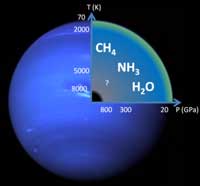
are water (H2O), ammonia
(NH3) and methane (CH4)
ices. The core may be
composed of rocks and ice;
the outside layer is formed
mainly by helium, hydrogen
and methane. Click on image
to enlarge.
Image courtesy of Sandra
Ninet; image of Neptune by
NASA / JPL-Caltech; model
adapted from Hubbard WB,
Podolak M, Stevenson DJ
(1995) The Interior of Neptune.
In Cruikshank DP (ed) Neptune
and Triton. pp. 109-138.
Tucson, AZ, USA: University of
Arizona Press.
ISBN 978-0816515257
Now scientists have confirmed the existence of superionic ammonia experimentally at the European Synchrotron Radiation Facility (ESRF): they submitted an ammonia sample to very high pressure while heating it, and followed its phase transformations using intense X-rays. Unexpectedly, however, they detected superionic ammonia at a lower temperature than predicted: 750 K instead of 1200 K. The exact boundaries of this superionic phase are crucial, because they determine whether it could exist in Neptune and Uranus.
Therefore, the scientists will next test whether superionic ammonia is stable under even higher temperatures and pressures. Should this be the case, it could help explain the origin of the planets’ magnetic fields, which are not yet well understood.
- To learn more, see the news item on the ESRF website or read the research paper:
Ninet S, Datchi F, Saitta AM (2012) Proton disorder and superionicity in hot dense ammonia ice. Physical Review Letters 108(16): 165702-1–165702-5. doi: 10.1103/PhysRevLett.108.165702 - Situated in Grenoble, France, ESRF operates the most powerful synchrotron radiation source in Europe.
European XFEL: The brightest light source on Earth
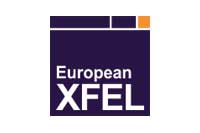
The European XFEL will deliver up to 27 000 very intense X-ray light flashes per second with a brightness more than 100 septillion (100 x 1024) times that of an ordinary 60 W light bulb, making the new research facility the brightest light source on Earth. Deliveries of the devices generating this incredible firework – the undulators – to the site in Hamburg have been taking place since October 2012. The magnetic structures of the undulators will force accelerated electrons onto a slalom course, inducing them to emit X-ray flashes of extraordinary quality.
The new facility will have three undulator systems, with the two larger ones each 212 m long. They consist of segments that have been produced in close collaboration with European XFEL. Before the segments are installed, the undulator group of European XFEL will extensively measure and tune their magnetic properties. The light they produce will eventually be used, for example, to examine biomolecules, to film ultrafast processes and to study matter under extreme conditions.
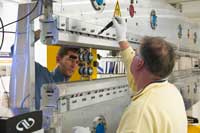
undulator in the magnetic
measurement laboratory.
Image courtesy of European XFEL
The European X-ray Free Electron Layer (XFEL) is a research facility currently under construction in the Hamburg area in Germany. Its extremely intense X-ray flashes will be used by researchers from all over the world.
ILL: Cold-blooded platypus and hot-blooded chicken
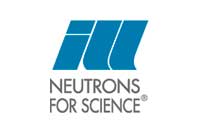
Using the facilities at the Institut Laue-Langevin (ILL), a team of biologists have shown that haemoglobin in different species has evolved to perform its function as an oxygen carrier very effectively at that species’ body temperature. They found variations in the amino-acid composition of this iron-rich protein, which is found in all vertebrates, that affect the protein’s softness and flexibility, and thus its ability to withstand warmer or cooler temperatures.
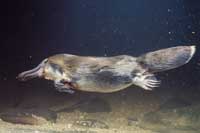
iStockphoto.com
The team studied haemoglobin from a range of vertebrates. The duck-billed platypus, at 33 °C, has the lowest body temperature of all endotherms (vertebrates that maintain a constant body temperature, such as mammals or birds). Humans, at 36.6 °C, have an intermediate body temperature, whereas the chicken, at 41 °C, is as hot-blooded as birds tend to be. The scientists also studied the ectothermic saltwater crocodile – which has a body temperature that is regulated by the environment, varying between 25 and 34 °C.

photopia.com
The scientists found a direct correlation between the resilience of haemoglobin and the average body temperature of the species from which it was sampled. In other words, each species’ haemoglobin appears to have evolved to unfold at exactly the right body temperature.

pixelio.de
- To learn more, see the press release on the ILL website or read the research paper:
Stadler AM et al. (2012) Thermal fluctuations of haemoglobin from different species: adaptation to temperature via conformational dynamics. Journal of the Royal Society 9(76): 2845-2855. doi: 10.1098/rsif.2012.0364 - ILL is an international research centre at the leading edge of neutron science and technology, based in Grenoble, France.






